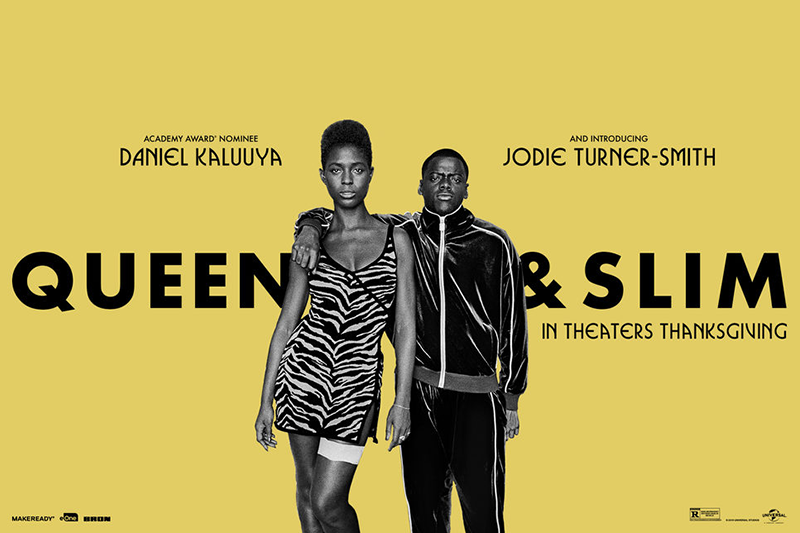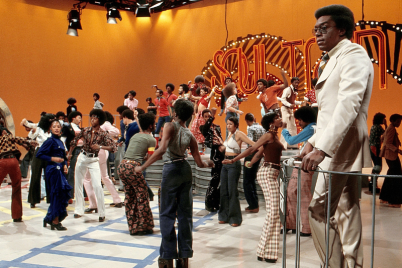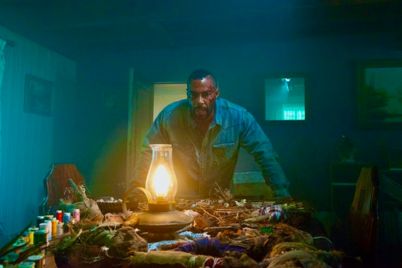“Queen & Slim” Directed by: Melina Matsoukas Screenplay: Lena Waithe Starring: Daniel Kaluuya, Jodie Turner-Smith, Bokeem Woodbine Rating: R (for violence, some strong sexuality, nudity, pervasive language, and brief drug use) Runtime: 132 minutes
“Oooh…well, if it ain’t the Black Bonnie and Clyde.” – Uncle Earl (Bokeem Woodbine)
Not really. Although the black love-on-the-run story “Queen & Slim” has drawn repeated references to the 1967 crime film “Bonnie and Clyde,” the only similarities are that the lead characters are two young lovers on the run from police. But similarities end there — because Bonnie and Clyde were actual criminals. White criminals.
In director Melina Matsoukas’ first feature film (she has a music video background, including Beyonce’s “Formation” video), the African-American lead characters — Ernest “Slim” Hines and Angela “Queen” Johnson – take action in self-defense.
The repercussions of their actions trigger a national frenzy when a photo snapped of the two on the run goes viral, engaging the country in their daring escape plan.
With such a grim set-up, maybe the film’s most powerful gift is its journey into a world of “uncut blackness.”
Screenwriter and creator of Showtime’s series “The Chi” Lena Waithe shared recently in Vanity Fair, that unadulterated blackness of “Queen & Slim” was intentional. “This feels different,” Waite is quoted. “We are not catering to a white audience. This film has not been put through a white gaze in any way.”
This is a rare if “never” occurrence: in this case, the strength of the story, alongside Waithe and Matsoukas’ shared Emmy (for an episode of Master of None), put studios into a bidding war over who would finance and release the film.
Universal won the bidding war, giving the filmmakers $17 million, and agreed to all their demands: release within the year, final cut, no notes from white executives, and an all-black test screening audience.
This allowed the filmmakers to construct “Queen & Slim” within a “black creators creating for black viewers” context — showing how black folks imagine black folks being black folks among black folks.
Even while escaping from the “long-(white man’s) arm-of-the-law.”
The final result? Millennial-era black joy and black love, “on the run,” but crafted with an unhurried specificity to its lead and supporting characters’ cultural nuances.
Daniel Kaluuya, who grabbed our hearts in “Get Out”‘ is once again a chill and pretty lovable every-day type as Slim; in her first film role, Jodie Turner-Smith is a traumatized and hardened Queen.
At the end of a failed first date, their destinies become permanently entwined, and it’s a testament to both actors that we’re with them almost immediately — experiencing their initial terror and fear, as well as their growing, respect, love, and desire, within an hour-and-a-half.
That at least one (black) reviewer has dismissed it as another “Black Lives Matter fueled saga” indicates where the American film audience is at this time when it comes to black creative production.
We’ve become fully aware of the racial dynamics of the time, including the ongoing police violence against brown and black people that brought on the Movement for Black Lives/ Black Lives Matter era. The paradoxes of some of us having achieved something equating to a little American “dime” – but at a cost that has been, for most of us, clearly not worth it.
This reality has meant that much of the film production that’s come out of this period has been firmly rooted within a context of black fear-and-disenfranchisement-vs white-fear-and-racism. Joy is hard to find, maybe a by-product; love is rarely even in the mix.
How novel is it, then, to experience the same era through a lens that prioritizes finding joy and love in-between “the rock and the hard place” that is contemporary America for black folks?
What makes “Queen & Slim” satisfying is that even on the run with the characters, we’re given the opportunity to view our complex, sometimes pleasurable, often harrowing cultural experiences untainted by the creative concerns of the white gatekeepers – who, by and large, decide what films we can see, where, and for how long.
“Queen & Slim” was created without the fear that viewers outside of the culture – viewers with a non-black gaze — would have problems relating to the characters, or have difficulties recognizing familiar cultural tropes or tendencies.
“Queen & Slim” was created without the fear that viewers outside of the culture – viewers with a non-“black gaze”— would have difficulties appreciating the two duos’ ways of living, loving and growing.
“Queen & Slim” was created without the fear that viewers outside of the culture – viewers with a non-“black gaze”— would have difficulties understanding why, even in the darkest moments of this often “bad dream” that America keeps turning out to be, we are steady empathizing with, praying for, or silently vowing to keep trying to save more black folks from falling into the cycles of poverty, exploitation, illness, or despair that many in our communities fall victim to.
If you’re a black American, this film is made for you – but “Queen & Slim” won’t save your soul, change your mind about anything, or even really teach you much you didn’t know about our current times.
What it will give you is 132 minutes of uncut black folks rooting for black folks who are learning to love each other, experience wonder, and enjoy the time they have under threat of imminent death.
And for $11, it felt worth it.








